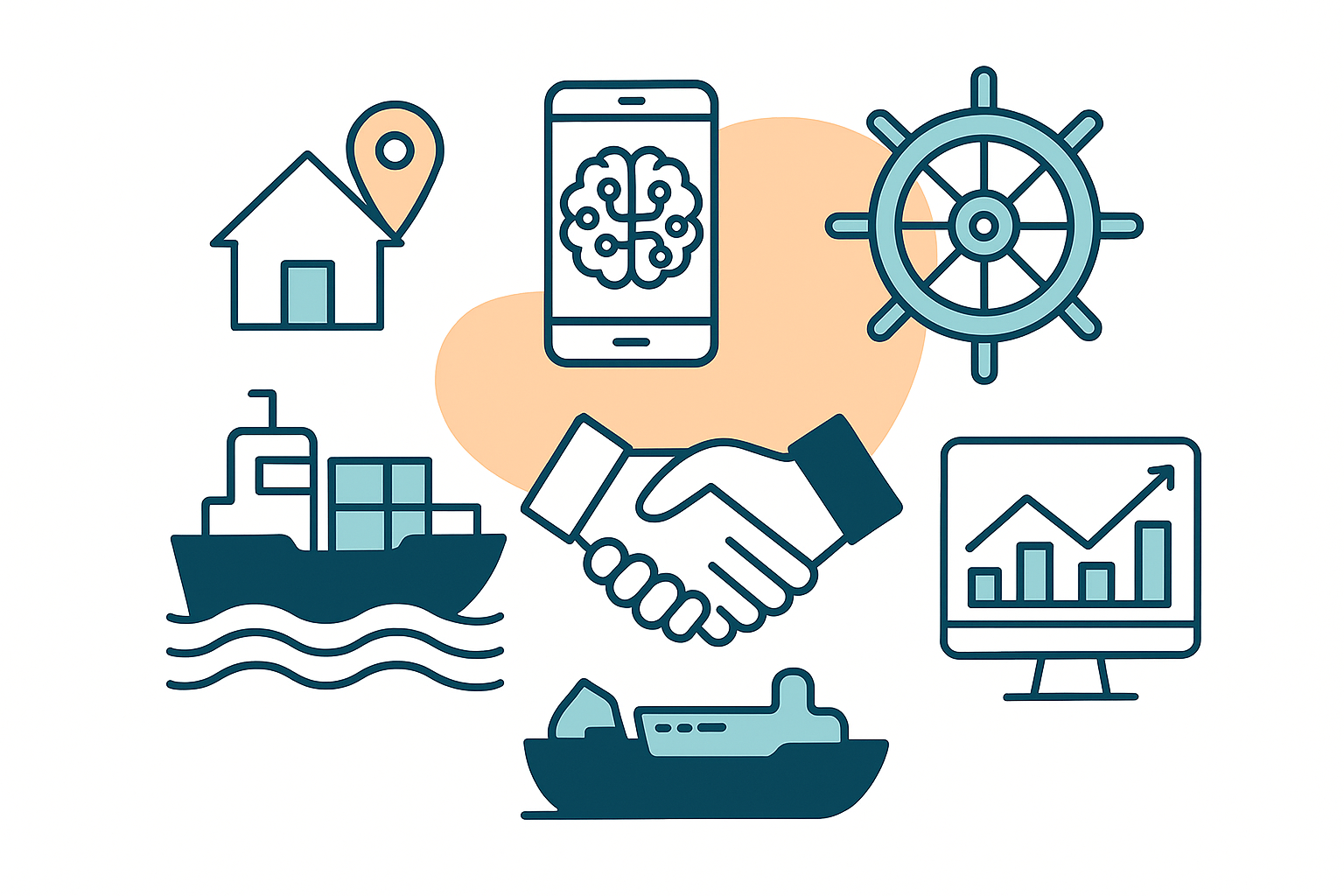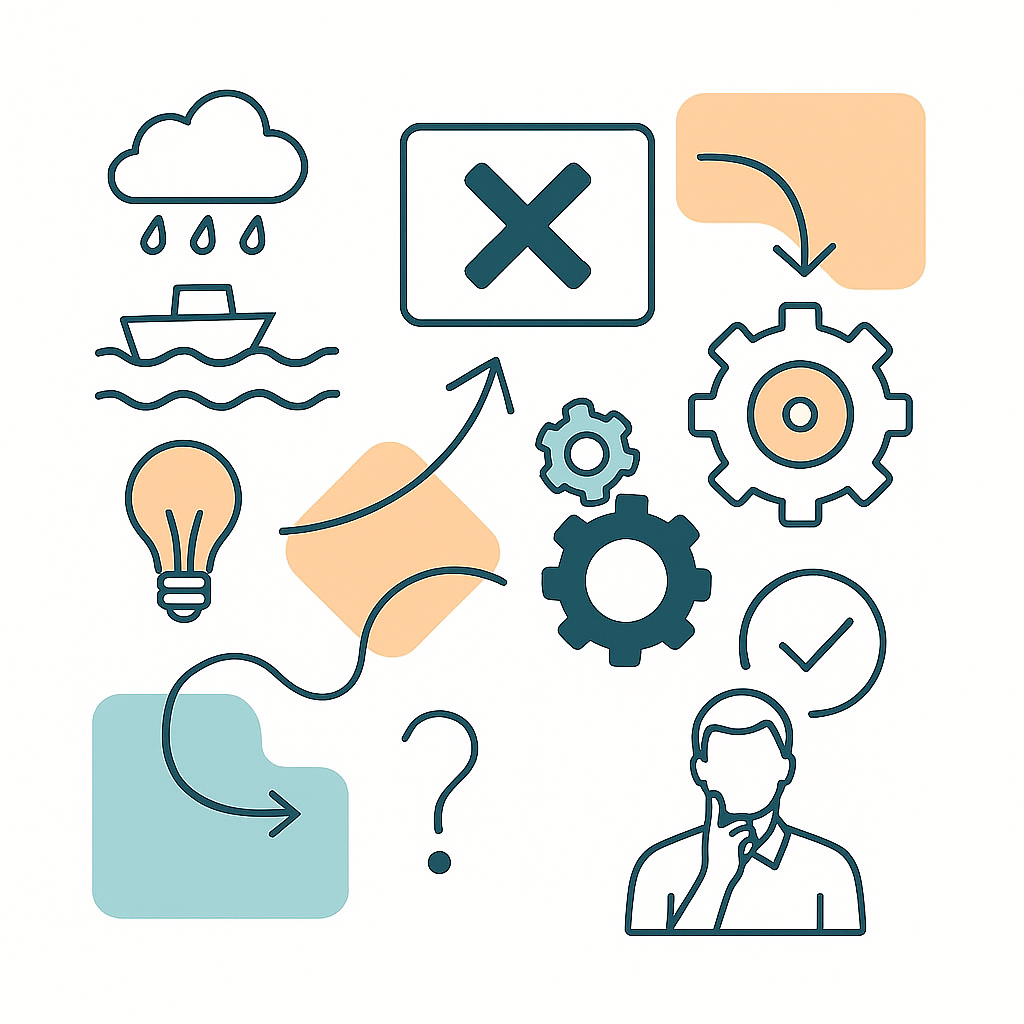Ships generate up to 120 megabytes of data daily, yet most of it goes unused. In an industry where a single delay can cost millions, that’s not just inefficient; it’s dangerous.
How can AI improve operations in maritime projects is no longer a futuristic question. The tide is turning, and those who adapt will redefine what smart shipping really means.
In this article, we will:
- Discover how AI cuts operational costs across maritime projects
- Select the right AI vendor for your maritime transformation needs
- Overcome common challenges when implementing AI in maritime operations
Maritime AI Mastery: 8 Ways to Slash Costs and Boost Efficiency
Maritime operations are being revolutionized by artificial intelligence, transforming everything from vessel navigation to cargo management. Smart shipping companies are implementing AI solutions to eliminate inefficiencies, reduce costs, and stay competitive in an increasingly complex industry.
Here are eight proven AI applications that deliver measurable results.
1. Optimize Vessel Routing and Fuel Efficiency
AI systems revolutionize navigation by turning complex maritime data into actionable routing decisions. These intelligent platforms process massive information streams in real-time to find the most efficient paths.
Key Applications:
- Weather-Aware Route Planning: AI algorithms analyze meteorological data and ocean currents to identify optimal sailing routes that minimize fuel consumption
- Dynamic Speed Optimization: Machine learning models continuously adjust vessel speed based on conditions to achieve maximum efficiency
- Real-Time Route Adjustments: Systems automatically recalculate routes when unexpected events occur, preventing costly delays
Implementation Note: Major shipping companies like Maersk have integrated AI route optimization into their fleet operations, combining satellite weather data with historical voyage patterns to make more informed navigation decisions.
2. Streamline Port Operations and Turnaround Time
AI transforms ports into smart logistics hubs that predict, plan, and execute operations with unprecedented precision, eliminating bottlenecks and reducing waiting times.
Revolutionary Applications:
- Predictive Berth Management: AI forecasts vessel arrivals and optimally allocates berths to minimize waiting times
- Automated Crane Scheduling: Machine learning coordinates container handling equipment to ensure optimal productivity
- Traffic Flow Optimization: Smart systems manage movements throughout port facilities for smooth cargo flow
Real-World Example: The Port of Rotterdam operates an AI-powered operations center that processes real-time data from thousands of sensors to coordinate vessel movements, demonstrating how smart ports can handle increasing cargo volumes more efficiently.
3. Enable Predictive Maintenance of Maritime Assets
Predictive maintenance represents a paradigm shift from reactive to proactive asset management. AI analyzes equipment behavior patterns to prevent costly breakdowns before they occur.
Advanced Strategies:
- Sensor Data Analysis: IoT devices monitor engine performance and structural integrity, feeding AI models that detect early failure indicators
- Failure Pattern Recognition: Machine learning identifies subtle patterns that precede equipment failures
- Maintenance Schedule Optimization: AI creates dynamic schedules based on actual equipment condition rather than arbitrary intervals.
Technology Insight: Modern vessels can be equipped with hundreds of sensors that continuously monitor everything from engine vibrations to hull stress, creating data streams that AI systems analyze to predict maintenance needs before equipment actually fails.
4. Enhance Cargo Handling and Tracking
AI-powered systems provide unprecedented visibility and control over shipments throughout the maritime supply chain, ensuring cargo integrity while optimizing handling processes.
Smart Features:
- Real-Time Visibility: IoT sensors with AI analytics provide continuous cargo monitoring throughout the journey
- Temperature Control: Smart systems automatically adjust environmental controls for sensitive cargo
- Damage Prevention: Computer vision detects potential cargo damage during operations and alerts operators
Industry Application: Temperature-sensitive cargo like pharmaceuticals and food products particularly benefit from AI monitoring, as systems can detect and correct environmental deviations before products are compromised, reducing waste and insurance claims.
5. Improve Crew Management and Fatigue Monitoring
AI revolutionizes maritime safety by transforming crew monitoring and management. These systems ensure optimal performance while maintaining the highest safety standards.
Intelligent Solutions:
- Biometric Monitoring: Wearable devices track vital signs to identify fatigue before it affects performance
- Workload Optimization: AI algorithms redistribute tasks to prevent overwork while maintaining efficiency
- Safety Alert Systems: Real-time monitoring detects dangerous behaviors and immediately alerts supervisors
Safety Focus: Given that human error contributes to the majority of maritime incidents, AI-powered crew monitoring represents a critical safety advancement, helping bridge operators maintain alertness during long voyages and complex operations.
6. Automate Documentation and Compliance Checks
AI eliminates the administrative burden by automating complex documentation processes and ensuring regulatory compliance across multiple jurisdictions.
Streamlined Processes:
- Natural Language Processing: AI automatically generates customs declarations and environmental reports
- Multi-Language Support: Smart translation ensures accurate documentation across different regulatory frameworks
- Compliance Monitoring: Real-time systems check operations against regulations and alert operators to violations
Operational Advantage: Maritime operations involve complex documentation requirements across multiple countries and regulatory bodies. AI systems can process these requirements simultaneously, reducing the administrative workload that traditionally requires dedicated personnel.
7. Support Autonomous and Remote Navigation
AI enables next-generation maritime navigation systems that operate with minimal human intervention while maintaining the highest safety standards.
Advanced Capabilities:
- Computer Vision Integration: AI-powered sensors create detailed environmental awareness, surpassing human capabilities
- Obstacle Detection: Machine learning identifies potential hazards including vessels, debris, and marine wildlife
- Decision Support: AI provides navigation recommendations based on a comprehensive environmental analysis
Development Status: While fully autonomous commercial vessels remain in development, current AI navigation assistance systems like Orca AI's SeaPod are already operational, providing enhanced situational awareness to bridge crews in challenging conditions.
8. Improve Decision-Making in Project Planning
AI transforms maritime project management by providing data-driven insights that enable better planning, resource allocation, and risk management.
Strategic Enhancement:
- Predictive Analytics: AI forecasts project timelines and bottlenecks based on historical data and market conditions
- Resource Optimization: Smart algorithms determine optimal allocation across multiple projects simultaneously
- Risk Assessment: Machine learning identifies potential risks and recommends mitigation strategies
Planning Advantage: Complex maritime projects involving multiple vessels, ports, and timeframes benefit significantly from AI’s ability to process vast datasets far beyond what’s typically outlined in a research project planning template and uncover smarter solutions.
Maritime organizations implementing comprehensive AI strategies typically achieve 200-300% ROI within 18 months through combined fuel savings, reduced downtime, and operational efficiency gains. The question isn't whether to adopt AI - it's how quickly you can implement these proven strategies to stay competitive.
Leading Maritime AI Solutions: Choose Your Technology Partner
Selecting the right AI technology partner can make or break your maritime digitalization strategy. The market offers both specialized solutions for specific challenges and comprehensive platforms for enterprise-wide transformation.

Top Maritime AI Vendors Comparison
Here's your guide to the leading maritime AI vendors and what they offer.
Choosing Between Off-the-Shelf vs Custom AI Solutions
When selecting AI tools, decide early between ready-made solutions and custom-built platforms:
- Off-the-shelf tools (like Orca AI or Wärtsilä) are faster to deploy and proven in the field.
- Custom-built AI platforms offer deeper integration with proprietary systems but require more resources and internal data readiness.
Pro Tip: If you're starting out, pilot with an off-the-shelf platform to demonstrate quick ROI, then scale or customize based on internal goals.
Maritime AI Implementation Roadblocks: Solutions That Work
Adopting AI in maritime operations isn’t plug-and-play - it requires overcoming real-world obstacles that can slow or even derail implementation. The good news? These barriers are solvable.
Here’s what typically stands in the way and how forward-thinking teams can move past them.

Integration with Legacy Ship Systems
Many ships rely on outdated control systems and analog infrastructure that weren’t designed for AI or digital transformation.
Key Challenges:
- Lack of compatibility with AI tools and real-time data streams
- Difficulty retrofitting sensors and software onto older hardware
- Data silos between onboard systems and onshore platforms
How to Overcome It:
- Start with modular AI platforms that can operate independently
- Use IoT edge devices that bridge the gap between analog inputs and cloud systems
- Prioritize newer fleet segments or high-impact routes for early pilots
Connectivity and Sensor Limitations at Sea
AI thrives on data, but data flow in open waters isn’t always guaranteed.
Key Challenges:
- Inconsistent satellite or internet connectivity
- Hardware limitations for collecting and transmitting real-time data
- Harsh environments that damage sensors or limit accuracy
How to Overcome It:
- Use edge computing, allowing AI to process data locally without constant cloud access
- Choose marine-grade, low-maintenance sensors built for salt, heat, and motion
- Sync data during port stops or when satellite windows are available
Data Privacy and Regulatory Hesitations
AI in maritime often involves cross-border data, crew monitoring, and compliance systems, raising legal and ethical concerns.
Key Challenges:
- Data sovereignty issues with cloud storage
- Varying regulations across international waters and jurisdictions
- Crew privacy concerns with biometric or behavioral monitoring
How to Overcome It:
- Implement localized data processing to meet jurisdictional compliance
- Use transparent crew policies and opt-in models for biometric tracking
- Work with vendors who offer compliance-ready solutions (e.g., GDPR, IMO)
Cost Anxiety and ROI Concerns
One of the biggest reasons maritime companies hesitate is the fear of sunk costs with no guaranteed payoff.
Key Challenges:
- Upfront investment in software, hardware, and training
- Lack of internal AI expertise
- Stakeholders are unsure of the timeline for returns
How to Overcome It:
- Begin with a pilot-first strategy, ideally outlined in a pilot project plan template focused on a single use case like fuel optimization.
- Use measurable KPIs to track savings, safety gains, or operational improvements
- Partner with vendors who offer staged implementation or performance-based contracts
Transform Maritime Pressure Points Into AI-Powered Wins
Maritime projects face constant pressure - from rising fuel costs to unpredictable port delays. But those pain points don’t have to stay problems. With the right AI strategies, shipping companies are gaining sharper control, faster decisions, and measurable savings.
From navigation to crew safety, automation to compliance, AI turns complexity into a competitive edge. Start turning operational friction into real-world wins - powered by data, driven by intelligence.


.png)
_light%201.png)





